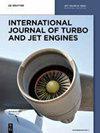进气射流预冷蒸发和阻力特性的定量研究
IF 0.9
4区 工程技术
Q4 ENGINEERING, AEROSPACE
引用次数: 1
摘要
摘要对采用喷雾装置的冷却段空气/薄雾耦合冷却进行了定量研究,旨在对两种径向喷雾装置(装置A和装置B)对流场变化的影响进行对比模拟。结果表明,由于冷却段的温度下降较大,均匀的喷雾布置可以改善流动性能。与装置A相比,装置B的温度下降系数高出1.60–2.25%,水分蒸发率高出1.1–3.0%。模拟了六种高空条件,发现喷雾装置和注水是造成流量损失的主要因素,而水蒸气引起的额外质量流量减少了损失量。在情况6中观察到最高的温度下降系数(27.3%),其中存在更均匀的喷嘴布置。在装置A和装置B之间观察到总压降系数方面的微小差异。此外,对于具有最大喷射率和最高进气马赫数的情况6,在喷雾系统的位置处观察到最高的总压降系数(5.8%)。本文章由计算机程序翻译,如有差异,请以英文原文为准。
Quantitative investigation of the evaporation and resistance characteristics of inlet jet precooling
Abstract A quantitative study is carried out to explore the air/mist-coupled cooling in the cooling section incorporating a spray device, aiming to conduct a comparative simulation on the effects of two radial spray arrangements (Apparatus A and Apparatus B) on the change of flow field. The results show that an even spray arrangement leads to improved flow performance owing to the large temperature drop in the cooling section. Compared with Apparatus A, Apparatus B enables a 1.60–2.25% higher temperature drop coefficient and a 1.1–3.0% higher water evaporation rate. Six high-altitude conditions are simulated to find that the spray device and water injection are the main factors causing flow loss, whereas the additional mass flow caused by water vapor reduces the amount of loss. The highest temperature drop coefficient is observed for Case 6 (27.3%), in which there is a more uniform nozzle arrangement. A slight difference in terms of total pressure drop coefficient between Apparatus A and Apparatus B is observed. Moreover, the highest total pressure drop coefficient (5.8%) at the location of the spray system is observed for Case 6, which has the largest injection rate and highest inlet air Mach number.
求助全文
通过发布文献求助,成功后即可免费获取论文全文。
去求助
来源期刊

International Journal of Turbo & Jet-Engines
工程技术-工程:宇航
CiteScore
1.90
自引率
11.10%
发文量
36
审稿时长
6 months
期刊介绍:
The Main aim and scope of this Journal is to help improve each separate components R&D and superimpose separated results to get integrated systems by striving to reach the overall advanced design and benefits by integrating: (a) Physics, Aero, and Stealth Thermodynamics in simulations by flying unmanned or manned prototypes supported by integrated Computer Simulations based on: (b) Component R&D of: (i) Turbo and Jet-Engines, (ii) Airframe, (iii) Helmet-Aiming-Systems and Ammunition based on: (c) Anticipated New Programs Missions based on (d) IMPROVED RELIABILITY, DURABILITY, ECONOMICS, TACTICS, STRATEGIES and EDUCATION in both the civil and military domains of Turbo and Jet Engines.
The International Journal of Turbo & Jet Engines is devoted to cutting edge research in theory and design of propagation of jet aircraft. It serves as an international publication organ for new ideas, insights and results from industry and academic research on thermodynamics, combustion, behavior of related materials at high temperatures, turbine and engine design, thrust vectoring and flight control as well as energy and environmental issues.
 求助内容:
求助内容: 应助结果提醒方式:
应助结果提醒方式:


